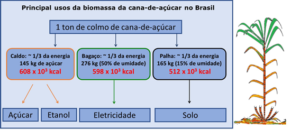Sugarcane Biomass
Brazil is the world’s largest producer of sugarcane, producing 633 million tons in an area of approximately 9 million hectares (CONAB, 2019). Most production occurs in the south-central region of Brazil, which accounts for more than 90% of national production.
Sugarcane biomass has historically been used in Brazil for the production of sugar and ethanol, products that are obtained from the juice extracted from the crop’s stalk. However, as shown in Figure 1, the juice represents only a little more than a third of the energy potential of sugarcane. Lignocellulosic residues, bagasse and straw, represent a large part of sugarcane’s energy potential.

Figure 1: Main uses of sugarcane biomass in Brazil. Adapted from UNICA 2013
Bagasse is a lignocellulosic residue resulting from the extraction of sugarcane juice for the production of ethanol and sugar. Brazil has a production potential of 162 million tons of bagasse, with the center-south region accounting for 92% of national production. Bagasse is mainly used for cogeneration of electricity. Currently, the electricity produced from bagasse (and from straw in lower quantities) is one of the main sources of electricity in Brazil and represents an important source of revenue for the national sugar-energy sector.
In recent decades the sugar-energy sector has undergone major transformations due to the prohibition of the prior use of fire before harvesting the crop and the advent of mechanized harvesting. Currently, mechanized harvesting without burning is adopted in about 92% of the cultivated area in Brazil and 97% of the cultivated area in the Center-South region (Conab, 2019). Consequently, significant amounts of sugarcane straw (8 to 20 t ha-1) have been kept in the field, especially in the Center-South region (Menandro et al., 2017). In the North-Northeast region, the area harvested with previous burning still corresponds to 75% of the cultivated area.
Straw covering the soil has come to support multiple ecosystem services in the soil-plant system, resulting in several agronomic and environmental benefits (Carvalho et al., 2017), such as: contribution to carbon accumulation (Tenelli et al., 2019), nutrient cycling (Cherubin et al., 2019), moisture maintenance (Corrêa et al., 2019), reduction of compaction (Castioni et al., 2019), reduction of erosion losses (Valim et al., 2016) and increase of biological activity (Menandro et al., 2019). In the plant, straw has come to directly interfere with sugarcane sprouting, growth, and productivity (Carvalho et al., 2019), and the incidence of pests in sugarcane fields (Castro et al., 2019).
More recently, the sugar-energy sector, after verifying the potential of this biomass as a raw material, has started to collect part of the straw for the production of renewable electric energy. With this objective, in recent years the National Laboratory for Biorenewables (LNBR/CNPEM) has conducted the Sugarcane Renewable Electricity Project (SUCRE-UNDP) which aimed to evaluate, among other indicators, the potential of sugarcane straw as a raw material for bioenergy production and the impacts of removing this residue in the soil-plant-atmosphere system. The SUCRE project was recently completed, and the main results can be accessed here.
Fundamental Bibliographical References
Comprehensive assessment of sugarcane straw: implications for biomass and bioenergy production
Agronomic and environmental implications of sugarcane straw removal: a major review
Multilocation Straw Removal Effects on Sugarcane Yield in South-Central Brazil
Technical and economic assessment of trash recovery in the sugarcane bioenergy
